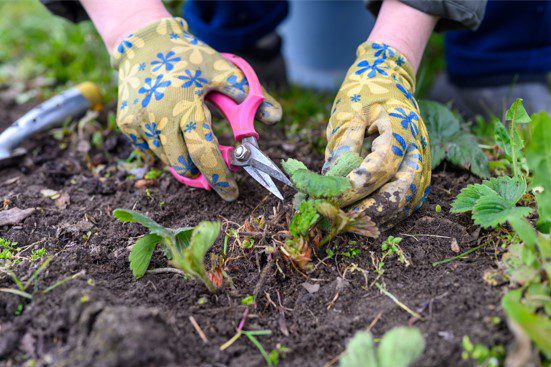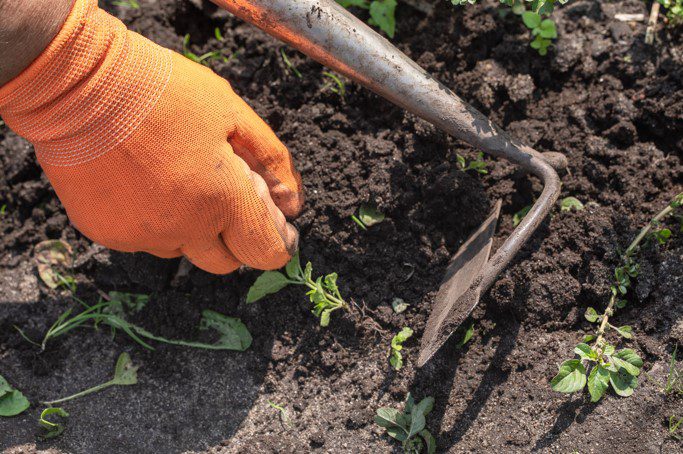Weeding is Very Important
Morning is a good time for weeding your garden, as it’s before the dew has dried. Although the soil may not be as soft after rain or watering, it will still be slightly softer than in the afternoon.
The recent rains intermingled with sunny days have helped produce lush plant growth, with area gardeners reporting that food and flower crops are one to two weeks early.
But nature does not discriminate. Along with plant growth comes a good crop of weeds. On recent gardens tours, I have been reminded of the advantages of a weed-free garden.
Not only were these gardens beautiful, with no weeds showing, but I’m also sure the bigger and healthier plants resulted in a large part from not having to compete with weeds for valuable moisture and nourishment.
Weeds compete so well, plant scientists tell us, because most of them can absorb more precious nutrients and water than the desirable plants around them.
Good planting techniques
By using a combination of good planting techniques, including soil conditioning, hoeing, cultivation, hand-weeding, and the use of mulches, many gardeners like myself have been able to avoid the use of synthetic (chemical) herbicides.
There are other control methods, too, such as a new — and apparently soil-friendly — herbicide called WipeOut, which is based on naturally occurring compounds found in soil micro-organisms.
The active ingredient in WipeOut is glufosinate, which creates a build-up of ammonia in the plant’s leaves and stems by blocking the production of a necessary photosynthetic enzyme, ultimately resulting in the death of the plant.
Soil activity
Jack Alex, Professor Emeritus at the University of Guelph and one of Canada’s foremost weed biologists, notes that the absence of soil activity is a key benefit to gardeners.
b”Unlike many products which effectively kill the soil by sterilizing it, the glufosinate quickly breaks down into harmless compounds, making replant possible in only a few days,” says Alex.
WipeOut, by Wilson Laboratories (a Canadian firm), is a biodegradable, non-selective herbicide which, according to the label, kills weeds and unwanted grass within four to seven days and allows replant in four days or less.
Over the last five years, I’ve been experimenting with a similar product from the United States sold under several names, including Round-up and Clear-it, containing glyphosate.
I learned that it generally kills all plant material that it touches, and once plants are growing, it must be used carefully. I’ve had the best success in these circumstances by shielding the good plants with something large like a flattened cardboard carton and then removing the wet shield quickly before it can touch any good plants.
Another beneficial use is where you want to kill all plant material in one area safely.
Two examples I have tried include spraying a vegetable garden after the first weeds have sprouted and before planting the wanted crop; and, secondly, spraying a lawn before sodding or seeding.
One of the greatest advantages of using a herbicide for weeding to get rid of weeds is killing the whole plant.
Peskiest weeds
This is of primary importance in controlling two of the peskiest weeds around here — dandelion and quackgrass.
Dandelions fall into a category of good and bad plants that can be propagated by pieces of the fleshy taproot. This has always meant that you must pull or dig up all of the dandelion roots because any small piece left in the ground will produce a whole new plant.
Just last month, I carefully dug up a dandelion and found three plants had sprouted from one piece of root left in the ground earlier.
As for quackgrass, the single most distinguishing feature of this aggressive perennial is it’s extensive creeping ivory-colored underground stems — rhizomes — that can grow very rapidly.
Every few inches along the rhizome, fibrous roots known as nodes appear. At each node, new above-ground stalks of vigorous unruly grass grow to a height of one to three feet.
They also easily propagate from the many seeds produced from spring to fall on their wheat-like flower heads.
The biggest nuisance factor of quackgrass control is that a single node in good growing conditions has been known to produce 14 rhizomes, totaling 458 feet in length in one year.
That means even if you leave a tiny piece in the ground, it could spawn a lot of new growth.
Several years ago, I was able to kill some quackgrass that came up with daylily root.
I carefully rubbed some Round-up on top of the quackgrass sticking above the daylily foliage.
Left No Single Weed
A single weed that is allowed to ripen and disseminate seed for one year only has the potential of developing several new plants each year for up to 100 years. The old farmer’s saying was that “One year’s seeding means seven years weeding.” We now know that the weed seed has more than a seven-year life span.
What about some of the other benefits that will accrue from weeding? Prickly lettuce and sow thistle serve as hosts for downy mildew—wild mustards host club root of cabbage.
The nightshades host the pepper weevil, and jimson weed supports red spider and potato flea beetle. The pest often overwinter on the weed and invades vegetables and flowers as the crops develop.

Insects do the same. They spend a part of their life cycle on weeds and the remainder feeding on our crops. Often the feeding insect will transmit diseases and viruses from tolerant wild plants to susceptible garden plants.
Weeds are, by their nature, aggressive. They steal a large share of the nutrients and water that are needed by the developing ornamental crop. The root system of many weeds is more extensive than are the roots of cultivated crops.
Weeds are prepared to develop a thick multi-branched stem growth that smothers planted crops. Weeds quickly grow taller than surrounding plants.
The root systems of some weeds produce chemical inhibitors that restrict the roots and the tops of ornamental plants. Remove the weeds, remove the negative chemical influences in the soil, and the named crop can grow.
Gardens look better with weeding. We may not know the name of the weed, but most people can identify that a given plant does not belong.
Final Word
All weeds will not be removed during one weeding session. Weed seed germinates at different times during the year, depending on the soil temperature.























